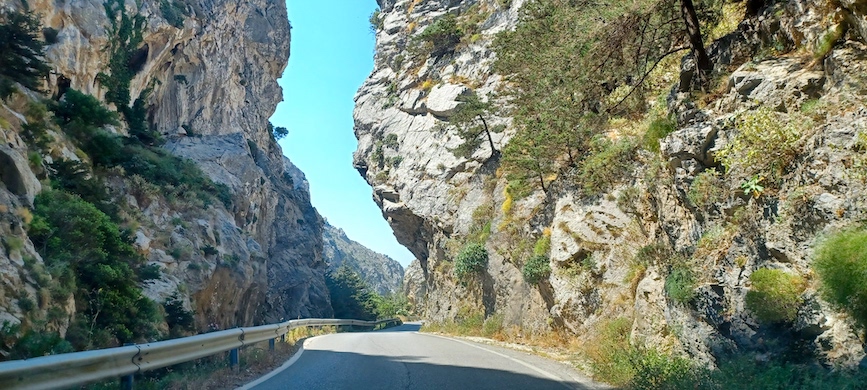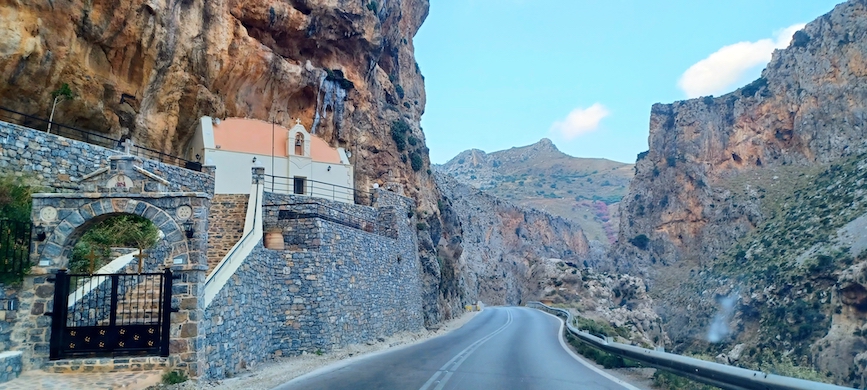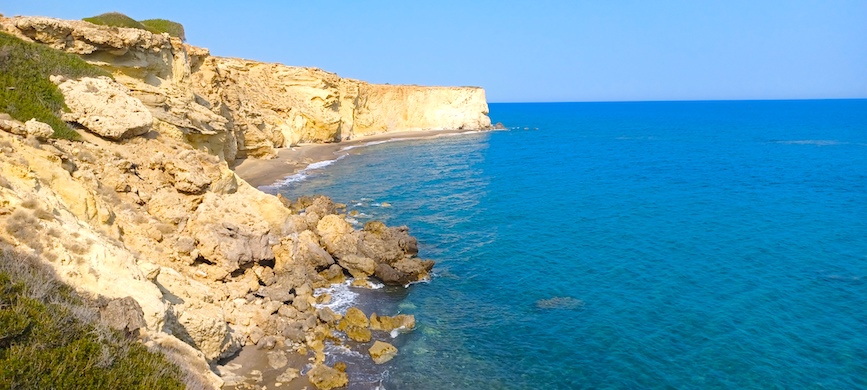Unpacked: Rambling Aboard the Ancient Aircraft Carrier Named Crete
Winding roads, Venetian walls, and cliff-top monasteries with a sense of history.

HERAKLION — There are no hotels at Tymbaki, a place renowned for nothing, though a well-known guidebook series calls it the ugliest town in Crete. It’s a place where watermelons grow like weeds and one that, for the foregoing reasons and others, I find almost impossible to resist in the heat of summer.
This outpost of Greek anti-chic on the remote south coast of Crete offers nothing anybody would ever want in a vacation.
Whitewashed lanes and cozy tavernas? Ha. You will never spot a Kardashian posting for Instagram here. Although there are beaches nearby, the heat and dust create the illusion they are a hundred miles away. The only tourists are either completely lost or barreling through on the way to someplace else, and therein lies part of the — well, it would be too charitable to call it charm, but let us say peculiarity of the sun-baked spot.
Tymbaki is in a geographic sense the lowest point of Crete, a honky-tonk agricultural trading post on the broad Messara Plain in one of the southernmost sections of Europe. The body of water to which it is closest is not the Aegean, but the Libyan Sea. There is a soupçon of ancient trade and wine-dark sea about the place and, indeed, above the shoreline at nearby Komos there are tantalizing ruins of a Minoan port, facing Africa, its secrets sealed off because excavations are ongoing.
And there you have it: This one-horse town that no amount of CGI could beautify is the fulcrum of life in south Crete, just as Crete is the cradle of European civilization and a lever of Western security in an increasingly fractured world.
In days gone by, long after the Bronze Age Minoan palaces were flattened by earthquakes and a tsunami following the volcanic catastrophe at Santorini, waves of Greeks, Romans, Arabs, crusaders, Venetians, Turks, more Greeks, and even some very unwelcome Germans fought for control over this elongated island that floats like a forested aircraft carrier between Europe, Africa, and the Middle East. The presence of the large Greek and NATO base at Souda Bay, on the island’s more developed north coast, is no accident.

Travel in south Crete has never been easy. The mountains plunge precipitously to the coast and it can take hours of navigating dizzying roads to pinpoint some of the more choice beaches. Sumptuous resorts are few and far between. One exception is a longtime personal favorite of mine called Irini Mare, situated in the coastal hamlet of Agia Galini just west of Tymbaki, which itself is about an hour’s drive south of Heraklion.
That, incidentally, is both Greece’s fourth-largest city and the one that feels the least Greek. Heraklion’s massive Venetian ramparts and sultry air make it seem like a holdover from a time of janissaries and pirates; the dark-haired locals move with a kind of Mediterranean swagger that suggests more kinship with Tel Aviv or Palermo than Athens. Its cramped, mixed civilian-military use airport is named for Nikos Kazantzakis of “Zorba the Greek” and “The Last Temptation of Christ” fame.
One morning at Heraklion I ran into the head of Greece’s socialist party, Nikos Andoulakis. We were both having breakfast at Megaron, the city’s finest hotel. It was the day before a national election and he was hungry, so talking politics seemed doubly uncouth; other Greek and Cretan topics were broached. At Athens, such spontaneous conversations with boldfaced names are a rarity. You will find them, but as in New York, no one has the time.
Cretan food, it is worth mentioning, is the best in Greece, and possibly the healthiest in Europe. Sometimes it comes with some pretty majestic views, too, as at Scala Premium Sea Food Bar, a gourmet haven due south of Heraklion at the former hippie village of Matala.
There and at Tymbaki, too, the traveler is going to have more dialogues with the locals, regardless of whether you speak Greek. The fruit seller will enthuse about his white peaches and cherries, the barista will want to know where you come from and whether you think Donald Trump’s hair is real, and the baker will tell you, politely, that despite what you thought was total command of your phrasebook you just asked for a pair of underwear instead of cheese pie with honey.
It has occurred to this correspondent that as far as travel stories go, this one is a bit of a ramble, but such is the consequence of my recent immersion into the Cretan transportation matrix.

There is no such thing as a straight road here; if you find one that runs even for more than a hundred feet it will be an aberration. You wanted to go there? Fine, but you ended up here. Along the way you might do a double-take from the driver’s seat as you realize that yes, you really did just see a rare Eleonora’s falcon flapping its wings a dozen or so yards beyond your windshield, a live and disconcertingly long snake dangling helplessly from its talons.
I wanted one afternoon to go to a beach bar somewhere west of Tymbaki, but I missed a turn or two and ended up at a monastery. It was one with a well-known beach below it and quite a past behind it.
In 1941, after the hard-fought 13-day Battle of Crete, the ravishing but remote area around Preveli monastery became a rallying point for hundreds of Allied soldiers who were trapped after the island fell to Nazi Germany. The soldiers defied ferocious German reprisals suffered by the resident monks and locals, who sheltered and provisioned them.
Protected by the monastery, a group of Australian soldiers spearheaded a risky rescue effort. The monks saved their hides by guiding them to the beachhead at Limni from where the soldiers escaped to a British submarine that was waiting offshore to ferry them to the Middle East.
A plaque commemorates the heroism of Father Agathangelos Laggonbardou for his role in the effort.

In retaliation, the Germans destroyed the lower section of the monastery, which dated to Byzantine times. It lies there still, fenced off and in ruins, a haunting reminder that the hounds of hell can be unleashed on even the most heavenly of landscapes.
Above it, high atop a cliff facing the sea, is the rest of the monastery, which has a fine museum and resembles a sepia-toned Tuscan village in miniature. The fact of its existence and enduring beauty is testament to an axiom seldom spoken but well understood throughout Greece: Do what you want, but don’t mess with the Cretans.
The real problem starts when you let Crete mess with your heart. If that happens, like it did to me, then you are going to be in for some serious trouble.
Unpacked is a periodic travel column from Mr. Grant in which he highlights or otherwise deconstructs a destination or experience of potential interest to today’s curious traveler.

